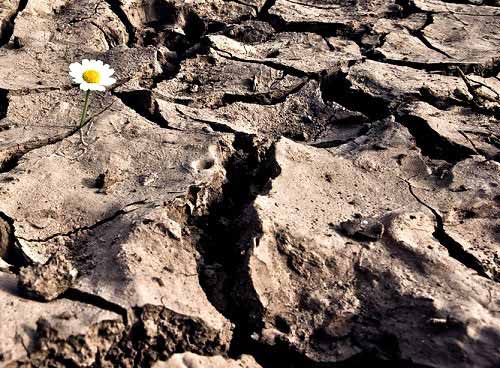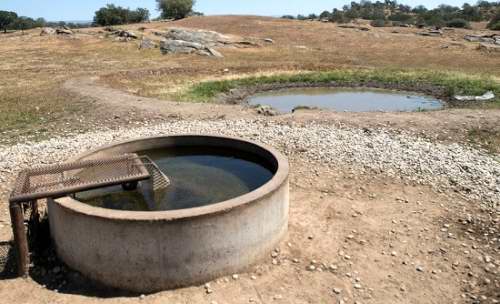Top 10 Drought Management Tips
For Your Cattle Pastures
1 2

Image Credit: Hernán Piñera
Drought management doesn't just happen during the drought years (part 1 of this article). It also happens during years when all is well. The preparations that you make during the fat years will make all the difference to how you weather the lean years.
Tips 6 to 10 (drought preparation)
6. Build up a drought-reserve of hay.
In wet years everyone is going to have lots of extra grass to bale up and sell. It pays not to run with the herd. Store some of that extra hay for yourself as a drought reserve instead of selling it.
If you never get around to using this hay reserve you can constantly refresh it by selling off some of your oldest hay in years when hay is expensive and rebuild your reserve during years when grass growth is high and hay is cheap. This vital hay reserve is what is going to let you press pause on your grazing rotation during drought years when you sense that your pasture regrowth is not keeping up with your grazing rotation.
7. Create your own emergency financial reserve (drought fund).
Droughts inevitably mean cattle prices will be depressed just when you are thinking of destocking because everyone will be destocking at the same time. Feed prices, meanwhile, will be higher than usual for obvious reasons. That's why your cash reserves are the most important aspect of your financial survival during a drought so you can continue to pay your debts, mortgage, and grocery bills.
Use the good years to build your cash reserves instead of plowing high profits into a new truck to offset your tax bill. Investing in a new truck during the good years won't help you during a drought. Investing in some bonds, paying down debt, or investing in stock shares that can readily be converted to cash when you need it (while paying dividends until you do need the cash) will help you weather the unpleasantness of a drought year far better than those who live large during the fat years and spend all they earn during the average years.
Drought years are not just about surviving a shortage in feed; it's also usually accompanied by a cash flow crisis unless you have the iron discipline to build up an emergency financial reserve even while watching your neighbors celebrate their high-profit years by buying new equipment, going on holidays, and buying toys.
8. Switch to DAILY pasture moves, leave a tall grass stubble during grazing, and combine your herds.
Although I've already discussed these grazing strategies earlier, they are not just for the lean years! By using these strategies as part of your regular grazing management strategy, they set in motion the changes to your pasture soils and plants that will make your pastures more drought resistant.
Daily pasture moves, leaving a tall stubble after grazing, and combining your herds are the three most effective tools for building up organic matter in the soil (which helps hold soil moisture like a sponge). Using these strategies in your everyday grazing management will also help to maximize plant ground cover on the soil (which helps shield the soil during a drought) by encouraging desirable grass to spread out while squeezing less desirable plants species from your pasture mix.
And if you're worried that daily pasture moves are expensive, think again! The smart electric fence grid used to manage a daily pasture rotation is the cheapest fence infrastructure you can use and will significantly reduce your both your management and your production costs. But you probably already know this if you've read my book or read the smart electric fence grid and the core grazing rules article series.
9. Build a few drought-proof water sites.
Relying strictly on shallow wells, surface water sources, or dugouts becomes a serious liability during a drought. It sucks to have pasture you can't use during an extreme drought because their water sources dry up. Making your cattle walk long distances through dust and searing heat to access distant water during a drought is also far from ideal, if it's even an option at all. So, instead of buying a new truck during the good years, invest in building a network of drought-proof water sites!
 Invest in some drought-proof water sites!
Invest in some drought-proof water sites!Image Credit: U.S. Dept of Agriculture
10. Prepare your "Drought Plan."
The time to prepare your drought management plan is when there isn't the slightest sign of a drought on the horizon. That's the time to not only plan your drought-proof infrastructure, but also the time to put together a systematic plan to build up and maintain hay reserves and emergency cash reserves.
It's also the time to plan out some of your responses to different drought scenarios:
- How will you monitor your pasture reserves? What are you looking for to cause you to starting to feed hay on pasture to let your pasture regrowth catch up?
- Identify which water sources are most vulnerable during a drought. Plan to graze these first.
- How aggressively will you cull early in a drought?
- What animals will you cull first if you identify that your feed reserves are getting tight?
Write down your answers! By planning these issues long before you face a drought you will have the perspective to put together a logical and well-rounded drought response that you can consult when the time comes. And when you're done planning, stick your drought plan into a big, well-labeled red binder on the most prominent shelf in your farm office where it's going to be easy to find.
The less decisions you have to make during a drought (because you've already pre-planned them), the better your drought response will be. Leaving all these decisions until a drought actually happens means you'll be under pressure and will make costly mistakes in your decision making process. And some things, like creating emergency hay reserves, building drought-proof water sites, and setting up the infrastructure for your smart electric fence grid simply can't be done on the fly - they take time and planning to set up while the grass is still lush.
I hope this article has given you a few extra drought management tools to add to your cattle farming toolbox and that it has given you a fresh perspective about the wide range of "normal" growing conditions that you need to consider in your farm plan
I also hope that it has given you some new ideas on what changes you can make to your farm to prepare your pastures and your business to be more drought-resistant in the future.
When fields are lush and green and there's rain pounding on the rooftop, it's easy to lose sight of all the critical drought preparations you ought to be making. It's a lot easier to remember the preparations you ought to have done when the fields are already burning up and the water holes are dry, but by then it's too late to make drastic changes and your options for how to respond to protect your cattle, land, and farm finances will be much more limited.
So use this article (and the sight of the dry grass in your pastures) to give yourself a big nudge to start making those preparations now. Grab your calendar and schedule some days over the coming months to create a comprehensive drought plan for your cattle farm.
(Disclosure: I get commissions for purchases made using Amazon links in my post.)
If you'd like to learn more about drought management and other grazing strategies for raising beef cattle on pasture, check out my book on Amazon.com: Grass-Fed Cattle: How to Produce and Market Natural Beef#CommissionsEarned.
Are you prepared for drought on your farm?
Are you struggling with drought on your farm this year? What are your favorite drought survival strategies? What changes have you made to make your pastures and your farm business more drought-resistant? I'd love to hear from you in the Comments section below.
...
Thanks for taking the time to read my article. I hope you've enjoyed it. If you'd like to be notified when I release future cattle farming articles, sign up for my email notifications or follow me on Facebook or Twitter.
Page 2 / 2




